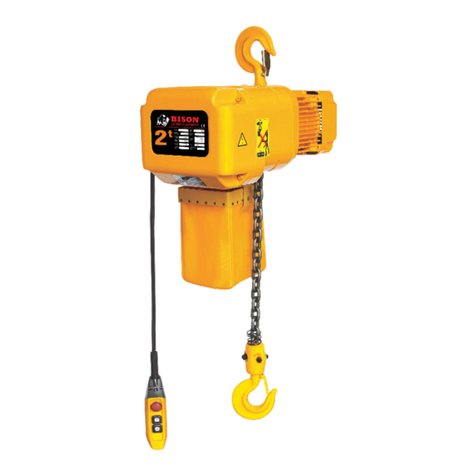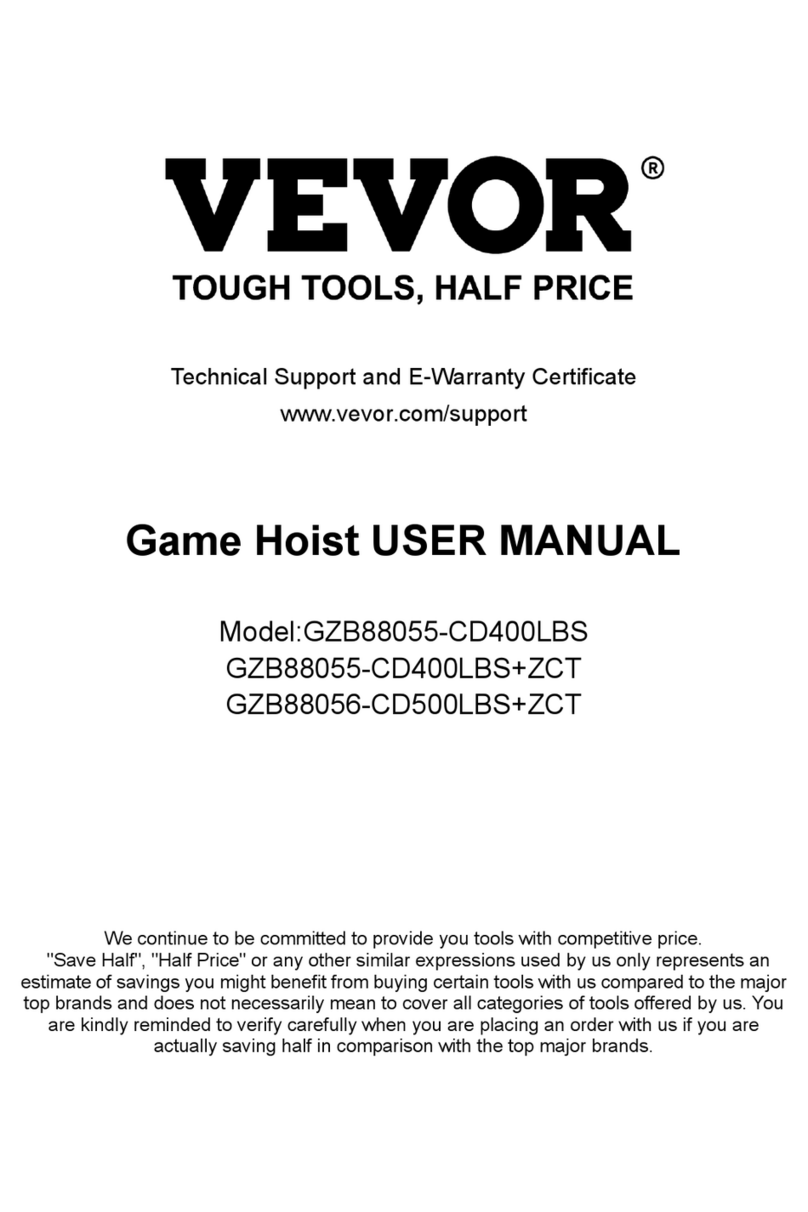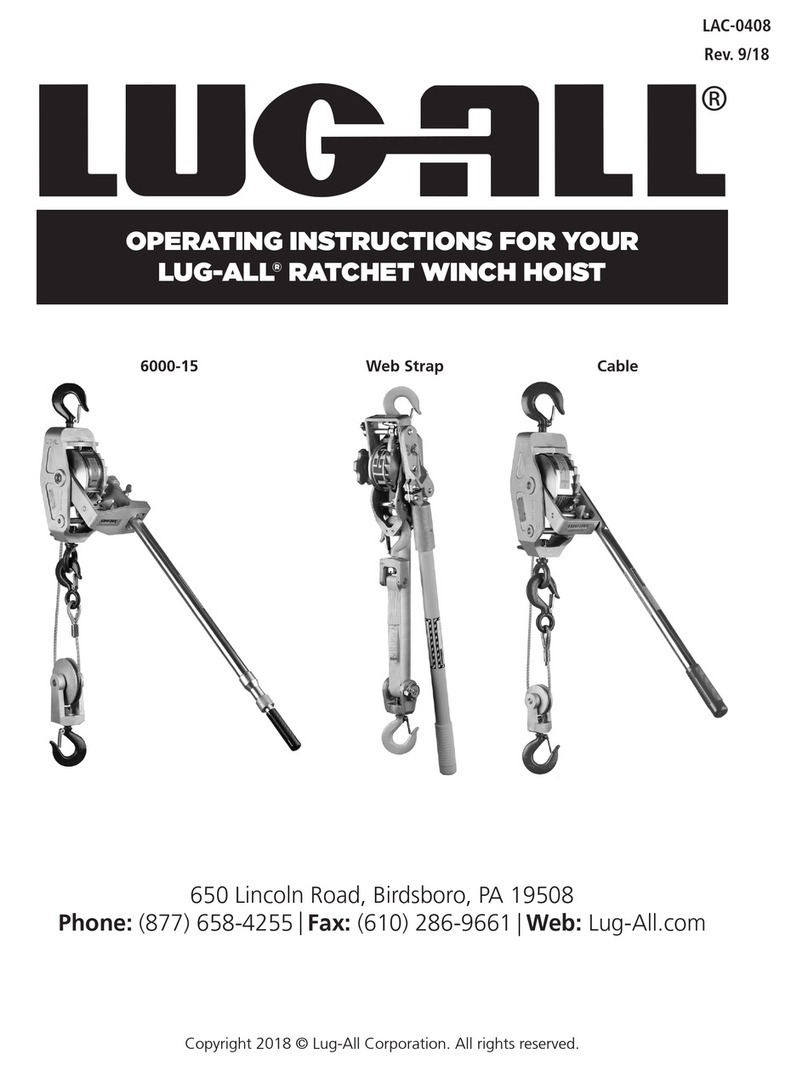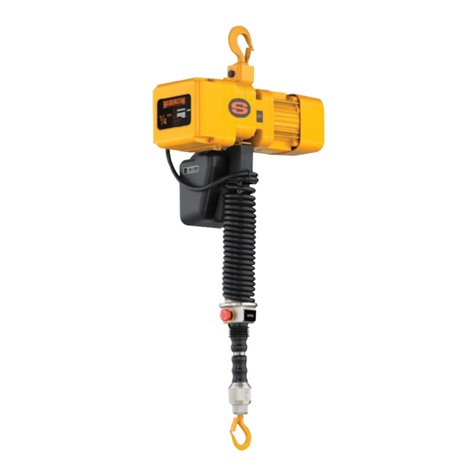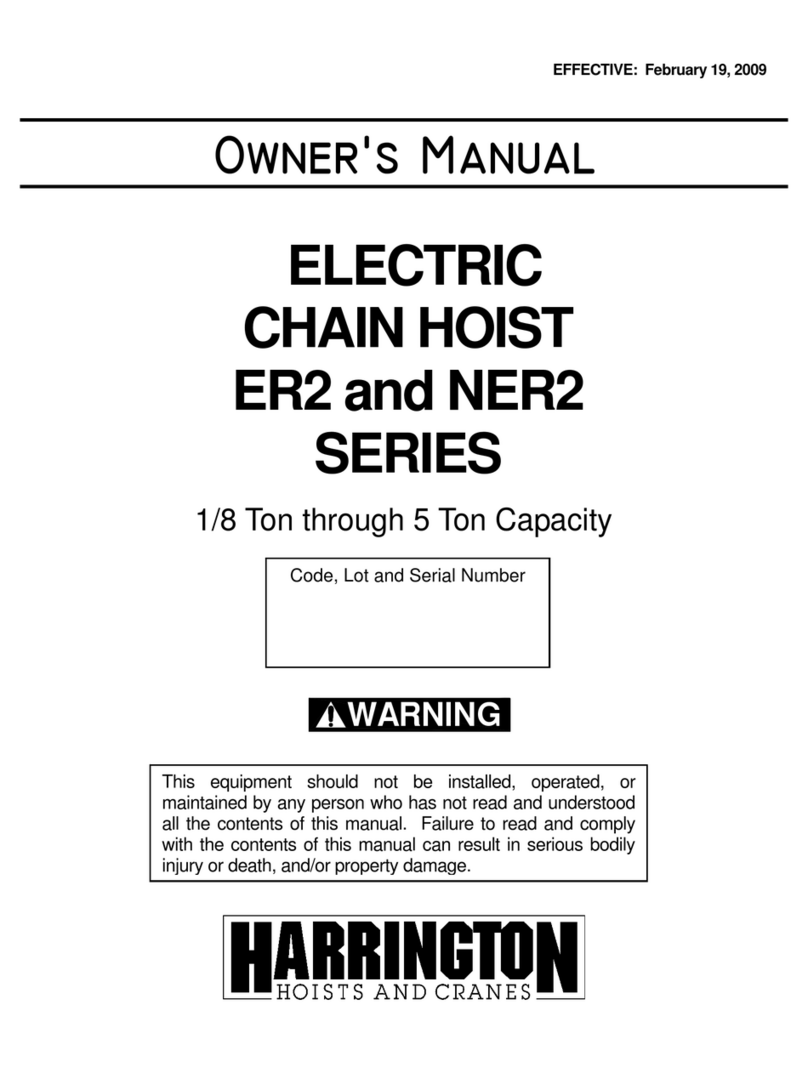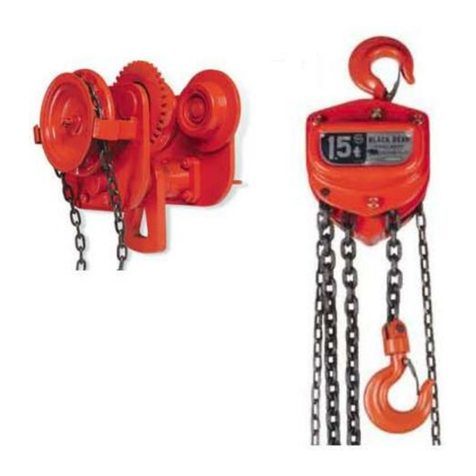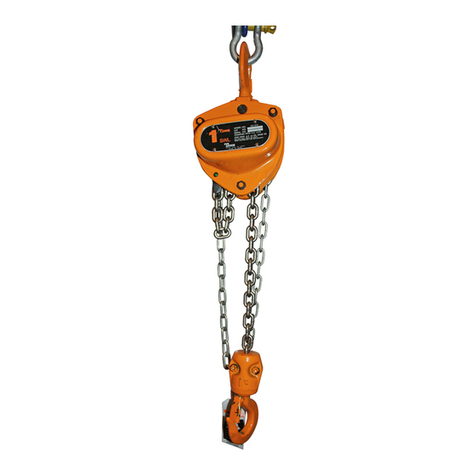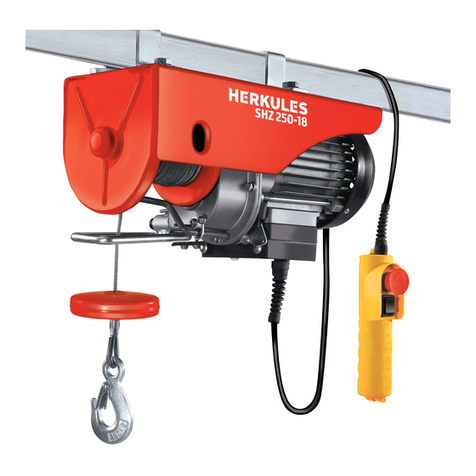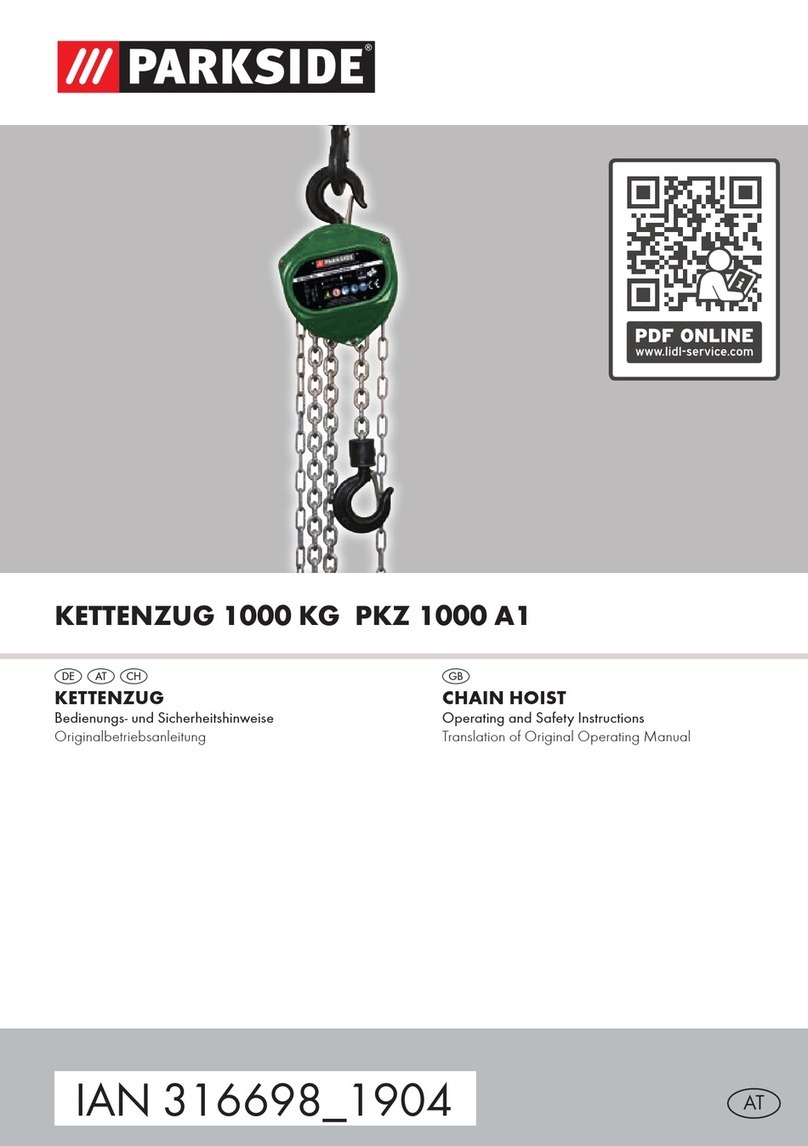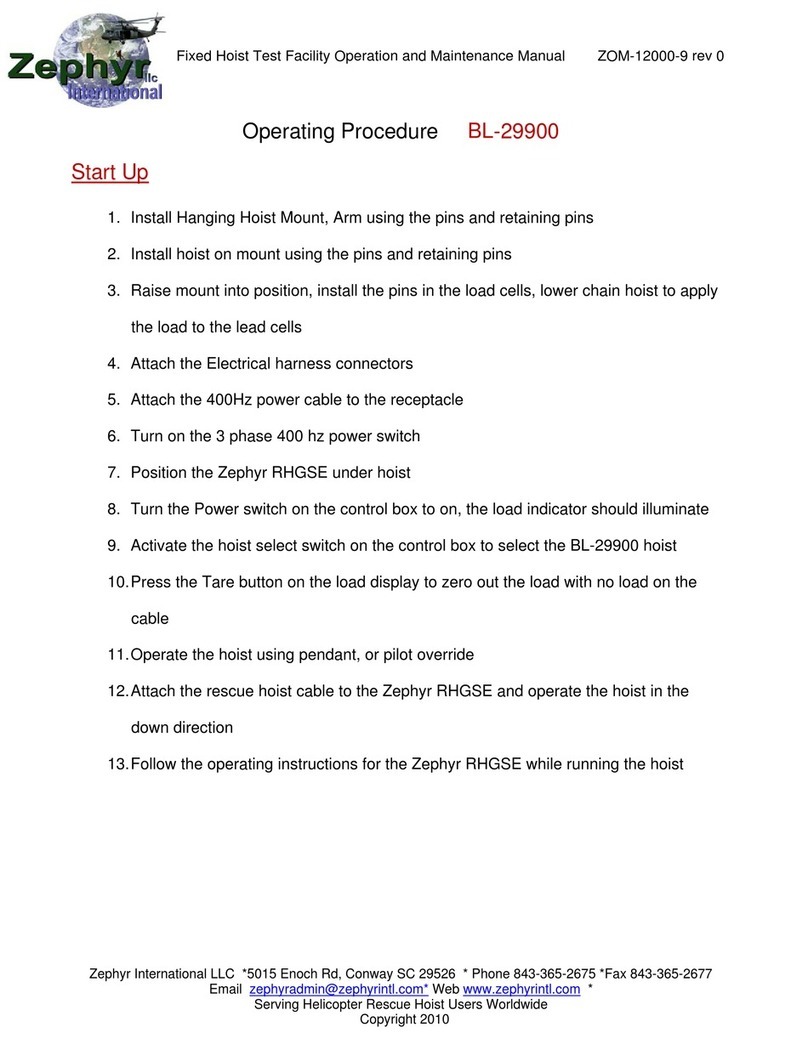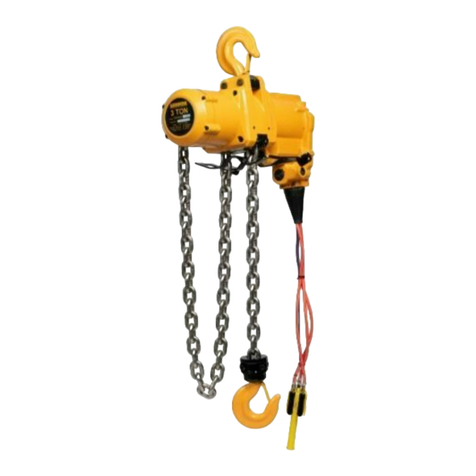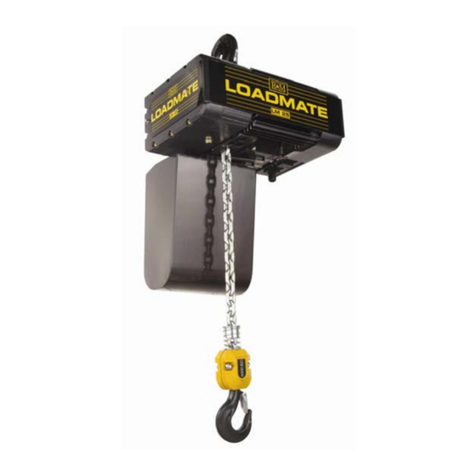Bison HHBD01SK-01 Operating instructions

1
ELECTRIC CHAIN HOIST
OPERATING AND
MAINTENANCE MANUAL
(Capacity: 1~5T)
3 Phase /230~460V 60HZ

2
Single Speed Hoist
Product
Code:
Cap.
Lift
Height
Lifting
Speed
Motor
Power
Power
Supply
Control
Voltage
Lifting Motor Rated
Current (amps)
Load Chain
Size Ø
Chain
Fall
Lines
Pendant
Cord Length
Total Net
Weight:
Tons
Ft
Ft/Min
HP.
Volts (3-
Phase) 60Hz
Volts
@230v
@460v
mm
Ft
Lbs
HHBD01SK-
01
1
20
23.62
2.01
230/460
48
6.5
3.25
8
1
18
125.66
HHBD02SK-
01
2
20
14.44
2.01
230/460
48
6.5
3.25
10
1
18
174.16
HHBD03SK-
01
3
20
17.72
4.02
230/460
48
13
6.5
11.2
1
18
308.65
HHBD05SK-
02
5
20
9.2
4.02
230/460
48
13
6.5
11.2
2
18
379.19
Product Code:
Cap.
Head Room (H)
A
B
D
E
K
L
N
Tons
Inches
Inches
Inches
Inches
Inches
Inches
Inches
Inches
HHBD01SK-01
1
19.69
23.43
12.60
11.81
7.87
1.57
1.22
0.94
HHBD02SK-01
2
23.62
25.39
12.99
12.60
9.06
1.93
1.37
1.18
HHBD03SK-01
3
29.53
30.91
15.55
18.31
10.63
2.32
1.65
1.38
HHBD05SK-02
5
38.58
30.91
15.55
18.31
10.63
2.36
1.65
1.69

3
Single Speed Hoist + Trolley
Product
Code:
Cap.
Lift
Height
Lifting
Speed
Motor
Power
Power
Supply
Control
Voltage
Lifting Motor
Rated Current
(amps)
Load
Chain
Size
Ø
Chain
Fall
Lines
Pendant
Cord
Length
Trolley
Speed
Trolley
Output
Trolley Motor
Rated Current
(amps)
Trolley
Flange Width
(inches)
Weight (Lbs):
Total Net
Weight
Tons
Ft
Ft/Min
HP
Volts (3-
Phase) 60Hz
Volts
@230v
@460v
mm
Ft
Ft/Min
HP
@230v
@460v
Min
Max
Hoist
Trolley
Lbs
HHBD01SK-
01+WPC01
1
20
23.62
2.01
230/460
48
6.5
3.25
8
1
18
32.81
0.54
2.97
1.48
3.15
6.3
125.66
88.18
213.85
HHBD02SK-
01+WPC02
2
20
14.44
2.01
230/460
48
6.5
3.25
10
1
18
32.81
0.54
2.97
1.48
3.23
7.01
174.16
103.62
277.78
HHBD03SK-
01+WPC03
3
20
17.72
4.02
230/460
48
13
6.5
11.2
1
18
32.81
0.54
4.13
2.06
3.94
7.09
308.65
125.66
434.31
HHBD05SK-
02+WPC05
5
20
9.2
4.02
230/460
48
13
6.5
11.2
2
18
32.81
1.01
4.13
2.06
4.33
7.09
379.19
180.78
559.97
Product Code:
Cap.
Head Room (H)
A
B
D
K
L
N
R
T
P
O
Tons
Inches
Inches
Inches
Inches
Inches
Inches
Inches
Inches
Inches
Inches
Inches
HHBD01SK-01+WPC01
1
18.11
23.43
12.60
11.81
1.57
1.22
0.94
5.59
9.09
8.11
4.37
HHBD02SK-01+WPC02
2
22.05
25.39
12.99
12.60
1.93
1.37
1.18
5.59
9.09
9.33
5.00
HHBD03SK-01+WPC03
3
27.95
30.91
15.55
18.31
2.32
1.65
1.38
5.59
9.09
10.43
5.51
HHBD05SK-02+WPC05
5
37.01
30.91
15.55
18.31
2.36
1.65
1.69
5.59
9.09
11.65
6.14

4
Dual Speed Hoist
Product
Code:
Cap.
Lift
Height
Lifting Speed
(Ft/Min)
Motor
Power
Power Supply
Control
Voltage
Lifting Motor
Rated Current
(amps)
Load
Chain
Size Ø
Chain
Fall
Lines
Pendant Cord
Length
Total Net Weight:
Tons
Ft
Fast
Slow
HP
Volts (3-
Phase) 60 Hz
Volts
@230v
@460v
mm
Feet
Lbs
HHBDSK01-
01D
1
20
24.9
8.31
2.01
230/460
48
6.5
3.25
8
1
18
147.71
HHBDSK02-
01D
2
20
19.68
6.56
3
230/460
48
9.5
4.78
10
1
18
196.21
HHBDSK03-
01D
3
20
17.72
5.91
4.02
230/460
48
13
6.5
11.2
1
18
330.69
HHBDSK05-
02D
5
20
9.2
2.80
4.02
230/460
48
13
6.5
11.2
2
18
412.26
Product Code:
Cap.
Head Room (H)
A
B
D
E
K
L
N
Tons
Inches
Inches
Inches
Inches
Inches
Inches
Inches
Inches
HHBDSK01-01D
1
19.69
24.21
13.39
11.81
7.87
1.57
1.22
0.94
HHBDSK02-01D
2
23.62
27.76
14.57
12.60
9.06
1.93
1.37
1.18
HHBDSK03-01D
3
29.53
33.27
17.13
18.31
10.63
2.32
1.65
1.38
HHBDSK05-02D
5
38.58
33.27
17.23
18.31
10.63
2.36
1.65
1.69

5
Dual Speed Hoist + Trolley
Product Code:
Cap.
Lift
Height
Lifting Speed
(Ft/Min)
Motor
Power
Power
Supply
Control
Voltage
Lifting Motor
Rated Current
(amps)
Load
Chain
Size
Ø
Chain
Fall
Lines
Pendant
Cord
Length
Trolley Motor
Speed (Ft/Min)
Trolley
Output
Trolley
Flange
Width
(inches)
Weight (Lbs):
Total Net
Weight
Tons
Ft
Fast
Slow
HP
Volts (3-
Phase)
60 Hz
Volts
@230v
@460v
mm
Ft
Fast
Slow
HP
Min
Max
Hoist
Trolley
Lbs
HHBDSK01-
01D+WPC01D
1
20
24.9
8.31
2.01
230/460
48
6.5
3.25
8
1
18
65.62
22.97
0.54
3.15
6.30
147.71
110.23
257.94
HHBDSK02-
01D+WPC02D
2
20
19.68
6.56
3
230/460
48
9.5
4.78
10
1
18
65.62
22.97
0.54
3.23
7.01
196.21
125.66
321.87
HHBDSK03-
01D+WPC03D
3
20
17.72
5.91
4.02
230/460
48
13
6.5
11.2
1
18
65.62
22.97
0.54
3.94
7.09
330.69
147.71
478.40
HHBDSK05-
02D+WPC05D
5
20
9.2
2.80
4.02
230/460
48
13
6.5
11.2
2
18
65.62
22.97
1.01
4.33
7.09
412.26
202.83
615.09
Product Code:
Cap.
Head Room (H)
A
B
D
K
L
N
R
T
P
O
Tons
Inches
Inches
Inches
Inches
Inches
Inches
Inches
Inches
Inches
Inches
Inches
HHBDSK01-01D+WPC01D
1
18.11
24.21
13.39
11.81
1.57
1.22
0.94
5.59
11.06
8.11
4.37
HHBDSK02-01D+WPC02D
2
22.05
27.76
14.57
12.60
1.93
1.37
1.18
5.59
11.06
9.33
5.00
HHBDSK03-01D+WPC03D
3
27.95
33.27
17.13
18.31
2.32
1.65
1.38
5.59
11.06
10.43
5.51
HHBDSK05-02D+WPC05D
5
37.01
33.27
17.23
18.31
2.36
1.65
1.69
5.59
12.24
11.65
6.14

6
Introduction
This manual is provided by Bison Lifting Equipment covering the safe operation and maintenance procedures for
the Electric Chain Hoist. This manual contains instructions on installation, general operating procedures and
maintenance instructions.
Contents
1. Electric Chain Hoist
2. Operators Manual
3. Warning Page
4. Test Certificate
Set-Up
Pre-Operation Inspection
After opening the crate, carefully inspect the hoist, load chain and chain container for damage that may have occurred
during shipment.

7
Dual Voltage Adjustment:
All hoists come with the option of using either 460v or 230v power supply. The default voltage on all hoists is 460v.
This can be adjusted as follows:
1. Transformer Connection: The transformer like the hoist is wired as standard from the factory for an incoming
power supply of 460v.The Red wire (0V) of the transformer is connected to T2 of the reversing contactor. The
Blue wire (460V) is connected to T3 of the same reversing contactor.
If the incoming power supply is changed to 230v then the Yellow wire of the transformer (230V) should be
connected to T3 of the reversing contactor. The Blue wire (460V) must be disconnected from T3 and well
insulated. Ensure the cable is insulated in a manner that will not allow it to float around in the panel.
2. Motor Connection: The Hoist motor is wired as standard from the factory for an incoming power supply of 460v.
There are 6 wires from the motor Labelled U1; V1; W1; W2; U2; V2. The standard 460v connection is
W2/U2/V2 are joined together and U1/V1/W1 are connected to T1/T2/T3 of the reversing contactor. For 230v
main incoming supply voltage then a parallel connection of the wires is required as follows: W2&U1 connect to
T1-U2&V1 connect to T2-V2&W1 connect to T3.

8
Installation
1. Install the hoist to a support structure. It is the user/ owner’s responsibility to ensure the chosen
support structure has the sufficient strength to support the hoist and the rated working load.
2. Connect the hoist to the appropriate power supply. (For hoists with motorized trollies, ensure the hoist
is correctly wired to the trolley before connecting the mains power supply)
3. Before using the hoist, apply oil to the chain for easier operation and to prolong the life span.
4. To attach the chain bag/ container run the hoist until it is fully extended (DOWN) and then fasten the
bag/ container to the hoist. Once the bag is securely fastened feed the slack chain (non-load bearing)
into the bag/ container. Then run the hoist in the reverse motion (UP), guiding the slack chain into the
bag/ container (only applicable for those models supplied with the bag/ container)
5. Before proceeding to hoist a load to a potentially dangerous height, test the hoist brake to ensure the
hoist can suspend and hold the weight from a safe height.

9
Hoists with Motorized Trolley
Installing an electric chain hoist to the motorized trolley and fitting the trolley to a beam:
1. Insert the suspension shaft into the side plate G and lock it with the suspension shaft bolt, slotted nut
and split pin. Ensure the branches of the split pin are fully bent.
2. Place the wheels of side plate G on the left flange of the beam, ensuring the side guide rollers are
contacting the flange.
3. Refer to the tables on pages 11 and 12. Adjust the spacers accordingly ensuring Suspender T of the
hoist is directly in line with the center of the beam.
4. Slide the hoist [suspension T] onto the suspension shaft.
5. Add the required amount of spacers onto the suspension shaft until the side guide rollers contact the
flange of the beam.
6. Place all excess spacers onto the shaft on the outer side of Side Plate S.
7. Lock the suspension shaft with the suspension shaft bolt, slotted nut and split pin. Ensure the
branches of the split pin are fully bent.
8. Connect the hoist to the trolley by inserting the trolley plugs into the hoist sockets. Make sure the
power supply, upper cord from the trolley [Plug 4P] (see diagram on page 10) is connect to the lower
socket of the hoist and the lower push button cord [Plug 5P] is connected to the upper socket of the
hoist.
9. Connect the pendant cord [Plug 8P] to the socket [Socket 8P] on the trolley switch box.
10. Attach the cord strain relief cable to the cord support on the trolley.
11. Once all plugs are correctly connected, screw the plugs in to secure them.

10
Power Supply Connection
The power supply cable connects directly to the trolley’s switch box. [WARNING: It is advised to use a
certified electrician when connecting the unit to the mains power supply]
1. After removing the switch box cover insert the cable into the switch box.
2. Allow enough cable length in the switch box for a comfortable connection. (the wires should never be
tightly drawn from their terminals point)
3. Fasten together cable holder A and B.
4. Connect the black, red and white wires to the terminals 1, 2 and 3 as shown above. Connect the green
and yellow (ground) wire to the ground terminal on the side of the terminal strip.
5. After all wires are tightly fastened in their terminals, seal the box with the cover.
(make sure no cables were twisted during these steps)

11

12

13
Operation
Hoisting:
Dual speed models are controlled by pushing the pendent buttons down in 2 stages of depression. Single
depression engages a slow speed. Full depression engages the fast speed.
Install the hoist to a support structure. It is the user/ owner’s responsibility to ensure the chosen support
structure has the sufficient strength to support the hoist and the rated working load.
Do not attempt to lengthen the load chain in any way.
Do not attempt to repair the hooks.
General:
1. The friction-clutch is designed to allow the first reduction gear to slip on an excessive overload. An
overload is indicated when the hoist will not raise the load. Also, some clutching noise may be heard if
the hoist is loaded beyond rated capacity. Should this occur, immediately release the raising control to
stop operation of the hoist. At this point, the load should be reduced to the rated hoist capacity. When
the excessive load is removed, normal hoist operation is automatically restored. [CAUTION: the friction
clutch is susceptible to overheating and wear when slipped for extended periods. Under no
circumstance should the friction clutch be allowed to slip for more than a few seconds.]
2. Before picking up a load, check to see that the hoist is directly overhead. Avoid off-center loading of
any kind.
3. Take up a slack load chain carefully and start hoisting load gently to avoid shock and jerking of the
load chain. If there is any evidence of overloading, immediately lower the load and remove the excess
load.
4. Do not allow the load to swing or twist while hoisting.
5. Do not allow the load to bear against the hook latch or the tip of the hook.
6. Make sure the pendant cord is straight and is not tangled in the chain. Be careful not to snag the cord
on any sharp edges or objects.
7. When handling material that is being immersed in water, baths or any liquid, use a chain sling to
prevent the hook block from having to be submerged- this will stop any liquid from penetrating the
bearing.
Precautions
- During overhead lifting operations, personnel should NOT stand beneath the suspended load.
- Prevent the load chain from dragging over sharp edges or corners.
- Be cautious of having fingers caught in the mechanisms.
- Do NOT leave a suspended load unattended.
- Do NOT attempt to lift people.
- Do NOT use the load chain to basket or choke a load.
- Do NOT drag or drop the hoist.
- Do NOT put the bottom hook through the loop of the chain. (only applicable on 2-fall models)

14
Maintenance
The inspection procedure advised is based on ANSI/ASME B30.16. The following definitions are from
ANSI/ASME B30.16.
Inspection Classification
The inspection procedure is divided into two general grades based upon the intervals at which inspection
should be performed.
Hoist Service Duty
Duty
Average % of rated capacity
Normal
0 to 33%
Heavy
33 to 67%
Severe
67 to 100%
Special
Special Conditions
Frequent: Operators are to make visual inspections as often as required.
- Normal Duty Service – monthly
- Heavy Duty Service – weekly to monthly
- Severe Duty Service – daily to weekly
- Special Duty Service – recommend being inspected by a qualified individual before and after
each operation.
Periodic: Qualified individuals are to make visual inspections as often as required.
- Normal Duty Service – annually
- Heavy Duty Service – semiannually (twice a year)
- Severe Duty Service – quarterly
- Special Duty Service – recommend being inspected by a qualified individual before and after
each operation.
Frequent Inspection
The following is required to be inspected frequently:
- All functional operating mechanisms.
- Functionality of limit switch
- Hoist braking system
- Hooks in accordance with ANSI/ASME B30.10
- Hook latches
- Load chain
- Load chain reeving

15
Periodic Inspection
The following is required to be inspected periodically:
ANSI/ASME B30.16 requires all hoists subject to disassembly of load suspension parts, to undergo a load test
after re-assembly to pass full inspection.
Requirements of frequent inspection:
- Evidence of loose bolts, nuts, or rivets.
- Evidence of wear, corrosion, cracks, or distortion to parts such as load blocks, suspension housing, chain
attachments, clevises, coupling, suspension bolts, shafts, gears, bearings, pins and rollers.
- Evidence of damage to bottom block assembly.
- Evidence of excessive wear on motor or load brake.
- Evidence of damage of supporting structure/ trolley.
- Direction labels on pendant control stations.
- Warning labels properly attached to the hoist.
- Load chain end connections.
- Evidence of wear, cracks or stretching on the load chain.
Brake Adjustment
Brake device should be checked and cleaned of all dust and oil every three months.
The air gap of the brake is as standard 0.078 inches. The gap should be measured between the brake drum
and pull rotor. The gap adjustment is done by turning the adjustment nut (refer to diagram above). Using a
feeler gauge, measure the gap. Adjust until set. If the gap will not set at 0.027 inches, disassemble the motor
brake and inspect all motor brake parts. If necessary, replace the brake drum or motor cover.
If the electric chain hoist is mounted to an electric trolley, it is important to inspect both brakes- Trolley and
Hoist.

16
The drum brake lining must be checked and measured to ensure there is sufficient friction material. If there is
absent brake lining or excessive wear, the brake drum and/or the motor cover should be replaced.
Brake Drum Lining (Single Speed)
Hoist Capacities:
Default
Replace
Inches
Inches
1 Ton
0.31
0.23
2 Ton
0.31
0.23
3 & 5 Ton
0.31
0.23
Brake Drum Lining (Dual Speed)
Hoist Capacities:
Default
Replace
Inches
Inches
1 Ton
0.28
0.20
2 Ton
0.28
0.20
3 & 5 Ton
0.28
0.20

17
Chain Inspection
Inspect the chain for excessive, stretch, wear, corrosion or cracks. If the load chain shows any of these signs,
the chain must be replaced immediately.
It is most vital that (P) and (D) be measured and inspected on the chain links.
1. Measure the pitch (P) for evidence of stretching. Using the table below as reference, ensure that the
measurement is within 5% tolerance of the original value. If the measurement reading is greater than the 5%
tolerance, the chain must be discarded.
2. Measure the diameter (D) for evidence of wear or corrosion. Using the table below as reference, ensure the
diameter is within 10% tolerance of the original value. If the measurement reading is less than the 10%
tolerance, the chain must be discarded.
Gear Box Oil Inspection
The hoist features a friction clutch. Ensure the oil reservoir is always kept at a sufficient level of volume. Keep
the hoist in the natural horizontal suspended position. Locate the oil plug on the top surface of the gear case,
use a Meropa 320 oil to fill the reservoir till sufficiently filled, refer to the chart below. [to drain the hoist during
service or transportation, remove the plug on the bottom of the gear case]
Load Chain Wear
Hoist Capacities:
D
A
B
P
1 Ton
8mm
10.3mm
26.3mm
24.0mm
2 Ton
10mm
12.5mm
33.2mm
30.0mm
3 & 5 Ton
11.2mm
14.0mm
37.2mm
34.0mm
Gear Oil Volume
Hoist Capacities:
Quarts
1 Ton
1.06
2 Ton
1.8
3 & 5 Ton
3.17

18
Trolley Brake Inspection
Inspect the trolley’s brake lining for wear.
- If the trolley’s brake lining measures the “Replace” value or a higher dimension, discard and replace
the trolley’s brake assembly.
(The Trolley brake is non-adjustable)
Contactor Inspections
Recommended Contactor Replacement
Frequency of Jogging
Replace contactor after: (Starts)
Jogging is rare
1,000,000
during 25% of operations
500,000
During 50% or more or operations
200,000
Refer to the chart above for the recommended work rating of the hoist’s contactors. (Jogging: when the pendant
control buttons are pressed quickly and repetitively in to move the hook in small increments)
Brake Drum Lining (Single Speed)
Hoist Capacities:
Default
Replace
Inches
Inches
1 Ton
0.31
0.23
2 Ton
0.31
0.23
3 & 5 Ton
0.31
0.23
Brake Drum Lining (Dual Speed)
Hoist Capacities:
Default
Replace
Inches
Inches
1 Ton
0.28
0.20
2 Ton
0.28
0.20
3 & 5 Ton
0.28
0.20

19
Hook Inspections
Inspect the hook for damage such as cracks, bends and excessive wear. While inspecting the hook, measure
points K, T and U. Refer to the table below to judge whether the measurement is within the tolerance or not. If
the measurement reaches the value in column “Replace” or greater, the hook needs to be replaced
immediately.
Ensure the hook has a safety latch and that it is not bent or damaged that could result in an application to slip
off or out the hook.
Records
Reports of hoist maintenance and inspections should be kept on record for reference and
maintenance scheduling.
General Maintenance:
• Gearing should be cleaned, and grease lubricated at least twice a year.
• Hooks: should be checked periodically for deformation and wear. Hooks should be replaced
immediately if signs of excessive rust, wear, cracks or deformation are shown.
• Ensure the load chain is kept straight and untangled when storing to prevent the chain from kinking or
twisting.
• Any hoists used out-doors should be covered up or stored in a clean dry environment when not in use.
Capacity:
Size of: T (inches)
Size of: U (inches)
Size of: K (inches)
Standard
Replace:
Standard
Replace:
Standard
Replace:
1
0.94
0.79
1.18
1.10
1.26
1.13
2
1.18
1.02
1.54
1.42
1.57
1.41
3
1.34
1.22
1.93
1.69
1.77
1.59
5
1.73
1.50
2.24
1.97
1.77
1.59

20
Troubleshooting
Trouble
Probable Cause
Remedy
No response from hoist
whilst operating buttons.
Lack of power supply.
Check to see you are getting the appropriate supply of power.
Loose cables or faulty
electrical components.
Remove the covers to inspect the cables and electrical
components for any obvious damage or loose connections.
Emergency stop button
is engaged.
Release the emergency stop button.
Hoist is responding but will
not operate.
Load is beyond hoists
capacity.
Decrease load
There is an obstruction
within the chains path.
Operate the hoist in the reverse action to loosen; clean and oil
the load chain.
Hoist is making a slipping
or clicking noise.
The hoist is being
overloaded.
Decrease load
Insufficient power supply
Check to see you are getting the appropriate supply of power.
Load brake is stuck.
Open the hoist exposing the brake assembly. Check to see if
the brake is disengaging when no load is attached.
Hoist continues to operate
after controls have been
released.
Damaged contactors or
push buttons
Replace contactors or push buttons.
Hoist fails to hold
suspended weight.
Dust or oil on brake disc
Replace brake disc.
Severe abrasion of
brake assembly.
Replace the brake.
Other manuals for HHBD01SK-01
1
This manual suits for next models
3
Table of contents
Other Bison Chain Hoist manuals
